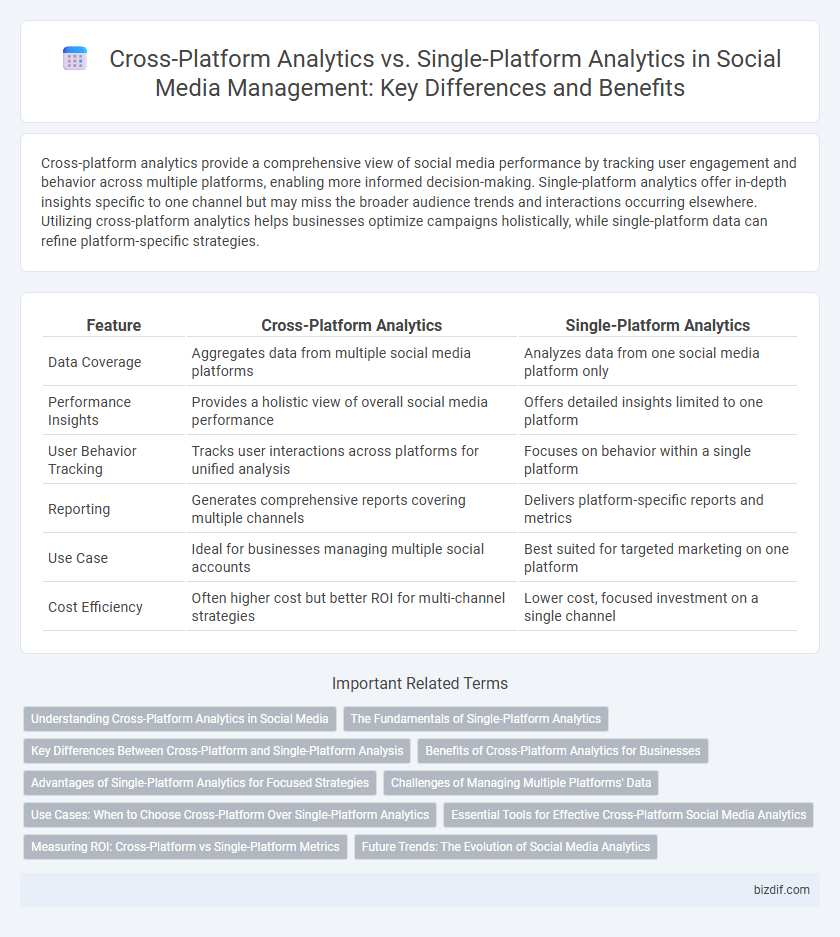Cross-platform analytics provide a comprehensive view of social media performance by tracking user engagement and behavior across multiple platforms, enabling more informed decision-making. Single-platform analytics offer in-depth insights specific to one channel but may miss the broader audience trends and interactions occurring elsewhere. Utilizing cross-platform analytics helps businesses optimize campaigns holistically, while single-platform data can refine platform-specific strategies.
Table of Comparison
| Feature | Cross-Platform Analytics | Single-Platform Analytics |
|---|---|---|
| Data Coverage | Aggregates data from multiple social media platforms | Analyzes data from one social media platform only |
| Performance Insights | Provides a holistic view of overall social media performance | Offers detailed insights limited to one platform |
| User Behavior Tracking | Tracks user interactions across platforms for unified analysis | Focuses on behavior within a single platform |
| Reporting | Generates comprehensive reports covering multiple channels | Delivers platform-specific reports and metrics |
| Use Case | Ideal for businesses managing multiple social accounts | Best suited for targeted marketing on one platform |
| Cost Efficiency | Often higher cost but better ROI for multi-channel strategies | Lower cost, focused investment on a single channel |
Understanding Cross-Platform Analytics in Social Media
Cross-platform analytics integrates data from multiple social media channels, offering a comprehensive view of audience behavior and campaign performance. This approach enables marketers to identify cross-channel trends, optimize ad spend, and improve overall strategy by analyzing interactions and conversions across platforms like Facebook, Instagram, Twitter, and LinkedIn. Single-platform analytics limits insights to one social network, missing the synergy and holistic understanding that cross-platform analysis provides for effective social media management.
The Fundamentals of Single-Platform Analytics
Single-platform analytics provides in-depth insights by focusing exclusively on one social media channel, allowing precise tracking of user engagement, content performance, and audience demographics specific to that platform. It enables marketers to optimize strategies based on platform-specific metrics such as Facebook's page likes, Instagram's story interactions, or Twitter's retweets. This focused approach simplifies data interpretation and helps tailor content strategies that align closely with the unique features and user behavior of a single social network.
Key Differences Between Cross-Platform and Single-Platform Analysis
Cross-platform analytics aggregates data from multiple social media channels, providing a comprehensive view of overall campaign performance and audience behavior across platforms. Single-platform analytics focuses on in-depth metrics within one social network, allowing for detailed insights into specific content engagement and audience demographics. The key difference lies in cross-platform analytics enabling integrated strategy optimization, while single-platform analysis provides granular data for tailored content and platform-specific growth.
Benefits of Cross-Platform Analytics for Businesses
Cross-platform analytics provides businesses with a comprehensive view of audience behavior by aggregating data from multiple social media channels, enabling more accurate performance measurement and strategic insights. This holistic approach helps identify trends, optimize content distribution, and improve return on investment across all platforms compared to single-platform analytics that only offer isolated data. Leveraging cross-platform analytics supports data-driven decision-making, enhances campaign effectiveness, and drives higher engagement rates across diverse social media ecosystems.
Advantages of Single-Platform Analytics for Focused Strategies
Single-platform analytics provide in-depth insights and granular data specific to one social media channel, enabling marketers to tailor strategies with precision. This focused approach enhances understanding of audience behavior and content performance unique to that platform, resulting in higher engagement and ROI. Brands utilizing single-platform analytics benefit from streamlined reporting and the ability to optimize campaigns based on highly relevant metrics.
Challenges of Managing Multiple Platforms' Data
Managing data from multiple social media platforms presents challenges in data integration, as each platform offers varying metrics and reporting formats that complicate consistent analysis. Cross-platform analytics tools help consolidate diverse data streams, but discrepancies in data granularity and update frequencies often lead to incomplete or delayed insights. Single-platform analytics lacks the holistic view necessary for comprehensive strategy optimization, making cross-platform solutions essential despite their complexity.
Use Cases: When to Choose Cross-Platform Over Single-Platform Analytics
Cross-platform analytics provides a comprehensive view of audience behavior and engagement across multiple social media channels, making it ideal for businesses targeting diverse demographics or running integrated marketing campaigns. Single-platform analytics is more suitable for brands concentrating their efforts on one dominant social network, where deep insights into specific user interactions and content performance are crucial. Opt for cross-platform analytics when evaluating overall campaign effectiveness, identifying cross-channel trends, and optimizing resource allocation across varied social media environments.
Essential Tools for Effective Cross-Platform Social Media Analytics
Essential tools for effective cross-platform social media analytics include Hootsuite Analytics, Sprout Social, and Buffer Analyze, which aggregate data from multiple platforms to provide comprehensive performance insights. These tools track metrics such as engagement rate, follower growth, and content reach across Facebook, Instagram, Twitter, and LinkedIn, enabling marketers to identify trends and optimize strategies efficiently. Unlike single-platform analytics, cross-platform solutions deliver holistic reports that enhance competitive benchmarking and multi-channel campaign management.
Measuring ROI: Cross-Platform vs Single-Platform Metrics
Cross-platform analytics provide a comprehensive view of social media performance by aggregating data from multiple channels, enabling more accurate measurement of overall ROI. Single-platform analytics limit insights to individual networks, potentially overlooking the interaction effects and audience behavior across different platforms. Leveraging cross-platform metrics enhances strategic decision-making by revealing broader engagement patterns and more holistic returns on marketing investments.
Future Trends: The Evolution of Social Media Analytics
Cross-platform analytics will dominate the future of social media management by integrating data from multiple networks like Facebook, Instagram, Twitter, and LinkedIn to provide comprehensive insights into user behavior and campaign performance. Advances in AI-driven algorithms and machine learning models enable predictive analytics, allowing marketers to anticipate trends and optimize strategies across diverse platforms. Single-platform analytics will remain essential for deep-dive analysis but will be supplemented by cross-platform tools to achieve a holistic view of brand engagement and ROI.
Cross-platform analytics vs Single-platform analytics Infographic

 bizdif.com
bizdif.com